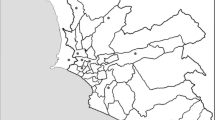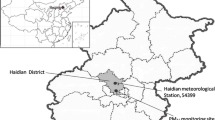Abstract
Particulate matter (PM) has been proven to cause health risks and may result in hospital emergency room visits (ERVs), which might be complicated by extreme temperature events. However, it remains unclear how temperature modulates the effect of different-sized particles on ERVs. This study used three separate time series analyses (2009–2011) to explore such temperature modulation effect in Beijing, China. The analytical approaches included a bivariate response surface model, a non-stratification parametric model, and a stratification parametric model. Results showed that the average daily concentrations of PM10 and PM2.5 in Beijing were 110.16 and 67.89 μg/m3, respectively, during the study period, which were higher than in most Western countries. Our findings indicated that the temperature modulation effects of PM2.5 were more evident than that of PM10. The effects of PM on morbidity depend on temperature. The effects were estimated for the increases in total, respiratory, and cardiovascular ERVs per 10 μg/m3 increase in PM2.5 and PM10 concentrations at high temperature level (> 28 °C). The estimated increases in the three types of ERVs for PM2.5 were 0.15, 0.35, and 0.34%, respectively. For PM10, the increases were 0.12, 0.08, and 0.14%, respectively. In addition, the results showed that the elderly (age ≥ 65) and women are more vulnerable to PM at high temperatures. These findings may have implications for the health impact associated with both air pollution and global climate change.


Similar content being viewed by others
References
Basu R, Samet JM (2002) Relation between elevated ambient temperature and mortality: a review of the epidemiologic evidence. Epidemiol Rev 24(2):190–202. https://doi.org/10.1093/epirev/mxf007
Cai W, Li K, Liao H et al (2017) Weather conditions conducive to Beijing severe haze more frequent under climate change. Nat Clim Chang 7(4):257–262
Carder M, McNamee R, Beverland I et al (2008) Interacting effects of particulate pollution and cold temperature on cardiorespiratory mortality in Schtland. Occup Environ Med 65(3):197–204
Costa DL, Dreher KL (1997) Bioavailable transition metals in particulate matter mediate cardiopulmonary injury in healthy and compromised animal models. Environ Health Perspect 105(5):1053–1060. https://doi.org/10.1289/ehp.97105s51053
Conti S, Meli P, Minelli G et al (2005) Epidemiologic study of mortality during the Summer 2003 heat wave in Italy. Environ Res 98(3):390
Dominici F, Mcdermott A, Zeger SL et al (2002) On the use of generalized additive models in time-series studies of air pollution and health. Am J Epidemiol 156(3):193
Dominici F, Mcdermott A, Hastie TJ (2004) Improved semiparametric time series models of air pollution and mortality. Publ Am Stat Assoc 99(468):938–948. https://doi.org/10.1198/016214504000000656
Dominici F, Mittleman MA (2012) China’s air quality dilemma: reconciling economic growth with environmental protection. JAMA 307(19):2100–2102. https://doi.org/10.1001/jama.2012.4601
Gordon CJ (2003) Role of environmental stress in the physiological response to chemical toxicants. Environ Res 92(1):1–7. https://doi.org/10.1016/S0013-9351(02)00008-7
Hastie T, Tibshirani R (1990) Generalized additive models for medical research. Stat Methods Med Res 4(3):187
Heyder J, Gebhart J, Rudolf G et al (1986) Deposition of particles in the human respiratory tract in the size range 0.005–15 μm. J Aerosol Sci 17(5):811–825
Kan HD, Jia J, Chen BH (2003) Temperature and daily mortality in Shanghai: a time-series study. Biomed Environ Sci 16(2):133–139
Kan H, Chen R, Tong S (2012) Ambient air pollution, climate change, and population health in China. Environ Int 42(1):10–19. https://doi.org/10.1016/j.envint.2011.03.003
Kan H, London SJ, Chen G et al (2008) Season, sex, age, and education as modifiers of the effects of outdoor air pollution on daily mortality in shanghai, China: the Public Health and Air Pollution in Asia (PAPA) study. Environ Health Perspect 116(9):1183–1188
Lee H, Honda Y, Hashizume M et al (2015) Short-term exposure to fine and coarse particles and mortality: a multicity time-series study in East Asia. Environ Pollut 207:43–51
Li G, Zhou M, Cai Y, Zhang Y, Pan X (2011) Does temperature enhance acute mortality effects of ambient particle pollution in Tianjin City. China Sci Total Environ 409(10):1811–1817. https://doi.org/10.1016/j.scitotenv.2011.02.005
Li H, Duan F, He K et al (2016) Size-dependent characterization of atmospheric particles during winter in Beijing. Atmosphere 7(3):36
Longueville FD, Hountondji Y, Ozer P et al (2014) The Air quality in African rural environments. Preliminary implications for health: the case of respiratory disease in the Northern Benin. Water, Air, & Soil Pollution 225(11):1–13
McGeehin MA, Mirabelli M (2001) The potential impacts of climate variability and change on temperature-related morbidity and mortality in the United States. Environ Health Perspect 109(2):185. https://doi.org/10.2307/3435008
Michelle LB, Ebisu K, Peng RD, Bell ML, Ebisu K, Peng RD, Samet JM, Dominici F et al (2009) Hospital admissions and chemical composition of fine particle air pollution. Am J Respir Crit Care Med 179(12):1115–1120. https://doi.org/10.1164/rccm.200808-1240OC
Peng RD, Bell ML, Geyh AS et al (2009) Emergency admissions for cardiovascular and respiratory diseases and the chemical composition of fine particle air pollution. Environ Health Perspect 117(6):957–963
Pope CA, Muhlestein JB, May HT et al (2006) Ischemic heart disease events triggered by short-term exposure to fine particulate air pollution. Circulation 114(23):2443–2448
Qiu H, Yu ITS, Wang X et al (2013) Season and humidity dependence of the effects of air pollution on COPD hospitalizations in Hong Kong. Atmos Environ 76(76):74–80. https://doi.org/10.1016/j.atmosenv.2012.07.026
Ren, Tong (2006) Temperature modifies the short-term effects of particulate matter on cardiovascular diseases in Brisbane, Australia. Int J Biometeorol 51(2):87–96. https://doi.org/10.1007/s00484-006-0054-7
Samet J, Zeger S, Kelsall J et al (1998) Does weather confound or modify the association of particulate air pollution with mortality? An analysis of the Philadelphia data, 1973–1980. Environ Res 77(1):9–19
Stafoggia, Forastiere, Schwartz (2007) Interaction between temperature and air pollution on mortality: an Italian multi-city case-crossover analysis. Epidemiology 18(Suppl):S140–S141. https://doi.org/10.1097/01.ede.0000276755.33765.e1
Tanabe SI, Kimura KI (1994) Effects of air temperature, humidity, and air movement on thermal comfort under hot and humid conditions. ASHRAE Trans 100(2):953–969
Vichit-Vadakan N, Ostro BD, Chestnut LG et al (2001) Air pollution and respiratory symptoms: results from three panel studies in Bangkok, Thailand. Environ Health Perspect 109(3):381
Wang M Z, Zheng S, He S L, et al. (2013) The association between diurnal temperature range and emergency room admissions for cardiovascular, respiratory, digestive and genitourinary disease among the elderly: a time series study [J]. Sci Total Environ, s 456–457(7):370–375
Wood SN (2003) Thin plate regression splines. J R Stat Soc 65(1):95–114. https://doi.org/10.1111/1467-9868.00374
Xin J, Wang Y, Wang L et al (2012) Reductions of PM2.5 in Beijing-Tianjin-Hebei urban agglomerations during the 2008 Olympic Games. Adv Atmos Sci 29(6):1330–1342
Xue D, Li C, Liu Q (2015) Visibility characteristics and the impacts of air pollutants and meteorological conditions over Shanghai. China Environ Monit Assess 187(6):363. https://doi.org/10.1007/s10661-015-4581-8
Ye X, Wolff R, Yu W et al (2012) Ambient temperature and morbidity: a review of epidemiological evidence. Environ Health Perspect 120(1):19–28. https://doi.org/10.1289/ehp.1003198
Yi OH, Hong YC, Ho K (2010) Seasonal effect of PM10 concentrations on mortality and morbidity in Seoul, Korea: a temperature-matched case-crossover analysis. Environ Res 110(1):89–95. https://doi.org/10.1016/j.envres.2009.09.009
Zheng S, Wang M, Li B, Wang S, He S, Yin L, Shang K, Li T (2016) Gender, age and season as modifiers of the effects of diurnal temperature range on emergency room admissions for cause-specific cardiovascular disease among the elderly in Beijing. Int J Environ Res Public Health 13(5):447. https://doi.org/10.3390/ijerph13050447
Zhou J, Ito K, Lall R et al (2011) Time-series analysis of mortality effects of fine particulate matter components in Detroit and Seattle. Environ Health Perspect 119(4):461. https://doi.org/10.1289/ehp.1002613
Funding
The study was supported by the Open Project Program of Shanghai Key Laboratory of Meteorology and Health (QXJK201601), the National key Research and Development Program of China (2016YFA0602004), the National Natural Science Foundation of China (91644226), and the National Scientific Data Sharing Platform for Population and Health (Professional Services for Meteorology, Environment and Public Health).
Author information
Authors and Affiliations
Corresponding author
Ethics declarations
Conflict of interest
The authors declare that they have no conflict of interest.
Additional information
Responsible editor: Philippe Garrigues
Rights and permissions
About this article
Cite this article
Zhang, Y., Wang, S., Fan, X. et al. Temperature modulation of the health effects of particulate matter in Beijing, China. Environ Sci Pollut Res 25, 10857–10866 (2018). https://doi.org/10.1007/s11356-018-1256-3
Received:
Accepted:
Published:
Issue Date:
DOI: https://doi.org/10.1007/s11356-018-1256-3




